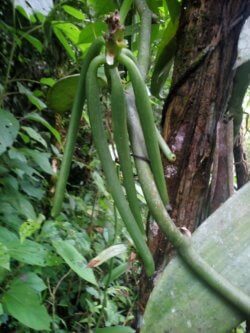The spice known by the name of vanilla has historically been obtained from various species of orchids. These species belong to the genus Vanilla, and some of the more common are: V. planifolia, V. Cribbiana, V. insignis, V. odorata, and V. pompona. V. planifolia (Photo 1) is the most cultivated species in the world. All of them are climbing plants, which extend in the lower and middle part of the canopy in a primary forest of tropical areas on the American continent. You can find vanilla growing here at Finca Luna Nueva Lodge.

Photo 1: Vanilla planifolia plant with fruits
The earliest written records of man’s use of this species date back to the 15th century. It is known that the Aztec king Izcatl, after conquering the Totonaco empire, forced that defeated empire to pay taxes. One such tax was Nahuatl (black flower) that would be used to perfume the chocolate of the Aztec nobles. We now know that Nahuatl is an ancient name of vanilla. Hernán Cortes first sent vanilla to Europe in 1519. Since then, vanilla has been an expensive and valuable item. It became a widely used and very cheap aroma after the discovery of the chemical synthesis of vanillin (4-hydroxy-3-methoxybenzaldehyde) in 1874. For years the cultivation of vanilla has become very small, but in recent years production in the world is increasing. Tropical islands, such as Madagascar and Reunion Island, have the climate to grow vanilla but none of its pests, and have become the world’s largest producers of vanilla.
In the wild we typically find very few vanilla vines growing in an area. The vanilla plant is a climbing liana that in nature lives hundreds of years, passing from one tree to another of the forest. These plants produce flowers only when they reach a certain size and never produce many. Its seeds are quite representative of classic orchids: small ones carried by the wind and that can only grow in very precise circumstances. Their natural pollinators are species of solitary (asocial) bees of the genus Euglossine.
This is not a favorable picture for vanilla in the wild today. Wild vanilla grows only in older forests, with very few individual plants per square kilometer, and it is pollinated by a bee that needs large forests to survive.These conditions have become rare. Of the known species of the genus vanilla (107 species) all are in critical danger of extinction in the wild. For example, researchers Arenas and Dressler in a 2010 work wrote that there was only one known living plant of each of the Costa Rican species V. costaricensis and V. sarapiquensis.
Due to its natural but not commercially productive pollinization strategy, humans must hand pollinate vanilla. This is the main reason why vanilla prices are so high. The increase in global demand for natural vanilla in recent years brings hope and new threats to vanilla species.
On the one hand, the economic value of vanilla encourages people to cultivate the plant, and in a selfish way we thus “allow” the plant to remain on the planet. Human cultivation is, unfortunately, ignoring the genetic diversity of wild vanilla species, which threatens to overly simplify or impoverish the genetic pool of the genus. Why is this? Because the intensive cultivation of vanilla is only carried out only with Vanilla planifolia, and all the cultivated plants are obtained by cloning. With this genetic simplification and the corresponding lack of genetic diversity, modern cultivation practices are thus repeating the same mistakes as we have previously discussed with respect to banana clones. We are creating the conditions for devastating diseases that will inevitably threaten the future of this genus, and we are losing the genetic resources that could help respond to such a existential crisis.
Hopefully you liked this discussion of vanilla and we see you soon again here.

